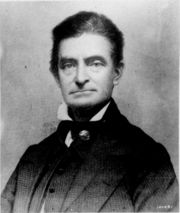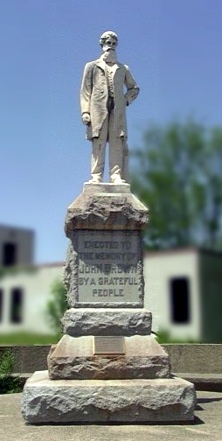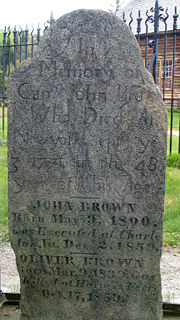|
Abolitionist John Brown Biography
(May 9, 1800 – December 2, 1859)
| Abolitionist John Brown |

|
| Abolitionist John Brown |
Abolitionist John Brown Introduction
John Brown believed that he could free the slaves, and he selected Harpers Ferry as his starting point. Determined to seize the
100,000 weapons at the Arsenal and to use the Blue Ridge Mountains for guerrilla warfare, abolitionist Brown launched his raid on Sunday evening, October 16, 1859. His 21-man "army
of liberation" seized the Armory and several other strategic points.
Thirty-six hours after the raid begun, with most of his men killed or wounded,
Brown was captured in the Armory fire engine house (now known as "John Brown's Fort") when U.S. Marines, led by Robert E. Lee, stormed the building. Brought to trial at nearby Charles Town, Brown was
found guilty of treason, of conspiring with slaves to rebel, and murder. He was hanged on December 2, 1859. John Brown's short-lived
raid failed, but his trial and execution focused the nation's attention on the moral issue of slavery and propelled the nation toward civil war.
| White Marble Statue of John Brown |

|
| Quindaro Townsite, Kansas |
John Brown was born
into a deeply religious family in Torrington, Connecticut, in 1800. Led
by a father who was vehemently opposed to slavery, the family moved to northern Ohio
when John was five, to a district that would become known for its antislavery views.
During his first fifty years, Brown moved about the country, settling in Ohio,
Pennsylvania, Massachusetts, and New York, and taking along his ever-growing family (He would father twenty children). Working
at various times as a farmer, wool merchant, tanner, and land speculator, he was never financially successful -- he even filed
for bankruptcy in his forties. His lack of funds, however, did not prevent him from supporting and promoting his beliefs.
He helped finance the publication of David Walker's Appeal and Henry
Highland's "Call to Rebellion" speech. He gave land to fugitive slaves.
His family even raised a black youth as one of their own. He also participated in the
Underground Railroad and, in 1851, helped establish the League of Gileadites, an organization
that worked to protect escaped slaves from slave catchers.
In 1847, Frederick Douglass met Brown for the first time
in Springfield, Massachusetts.
Regarding the meeting, Douglass exclaimed that "Though a
white gentleman, he [Brown] is in sympathy a black man, and, as deeply interested in our cause, as though his own soul had
been pierced with the iron of slavery." It was at this meeting that Brown first outlined his plan to Douglass to lead a war to free slaves.
| John Brown's Tombstone |

|
| North Elba, New York. |
Brown moved to the
black community of North Elba, New York, in 1849. The community had been established by philanthropist Gerrit Smith, who donated
tracts of at least 50 acres “to black families willing to clear and farm the land.” Brown, knowing that many of
the families were finding life in this isolated area difficult, offered to establish his farm there in order to lead by example
and to act as a "kind father to them."
Despite his contributions to the antislavery cause, Brown did not emerge as
a figure of major significance until 1855 after he followed five of his sons to the Kansas Territory. There, he became the leader of antislavery guerrillas and fought a proslavery attack against the
antislavery town of Lawrence. The following year, in retribution
for another attack, Brown went to a proslavery town and brutally killed five of its settlers. Brown and his sons would continue
to fight in the territory and in Missouri for the rest of
the year.
Brown returned to the east and began to think more seriously about his plan for a war in Virginia against slavery. He sought money to fund an "army" that he would lead. On October
16, 1859, he initiated his plan with 21 other men -- 5 blacks and 16 whites -- and
raided the federal arsenal at Harpers Ferry.
Brown was wounded and quickly captured,
and moved to Charlestown, Virginia, where he was tried and "convicted of treason." Before hearing his sentence, Brown was
allowed make an address to the court.
". . . I believe to have interfered as I have done, . . . in behalf of His despised poor, was not wrong, but right.
Now, if it be deemed necessary that I should forfeit my life for the furtherance of the ends of justice, and mingle my blood
further with the blood of my children, and with the blood of millions in this slave country whose rights are disregarded by
wicked, cruel, and unjust enactments, I submit: so let it be done."
Although initially
shocked by Brown's exploits, many Northerners began to speak favorably of the militant abolitionist. "He did
not recognize unjust human laws, but resisted them as he was bid. . . .," said Henry David Thoreau in an address to the citizens
of Concord, Massachusetts.
"No man in America has ever stood up so
persistently and effectively for the dignity of human nature. . . ."
John Brown,
sentenced by Judge Richard Parker, was hanged on December 2, 1859. (See also: Abolitionist John Brown: Life, Trial and Execution, Kansas Civil War History, and Missouri Civil War History.)
Sources: Harper's Ferry National Historic Park; PBS Online; Official Records
of the Union and Confederate Armies; National Archives (photograph); Library of Congress (picture).
Recommended Reading:
John Brown, Abolitionist: The Man Who Killed Slavery, Sparked the Civil War, and Seeded Civil Rights. Description:
An authoritative new examination of John Brown and his deep impact on American history. Continued below…
Bancroft Prize-winning cultural
historian David S. Reynolds presents an informative and richly considered new exploration of the paradox of a man steeped
in the Bible but more than willing to kill for his abolitionist cause. Reynolds locates Brown within the currents of nineteenth-century
life and compares him to modern terrorists, civil-rights activists, and freedom fighters. Ultimately, he finds neither a wild-eyed
fanatic nor a Christ-like martyr, but a passionate opponent of racism so dedicated to eradicating slavery that he realized
only blood could scour it from the country he loved. By stiffening the backbone of Northerners and showing Southerners there
were those who would fight for their cause, he hastened the coming of the Civil War. This is a vivid and startling story of
a man and an age on the verge of calamity.
Recommended Reading: Patriotic Treason:
John Brown and the Soul of America
(Hardcover). Description: John Brown is a lightning rod of history. Yet he is poorly understood and most commonly described
in stereotypes -- as a madman, martyr, or enigma. Not until Patriotic Treason has a biography or history brought him so fully
to life, in scintillating prose and moving detail, making his life and legacy -- and the staggering sacrifices he made for
his ideals-fascinatingly relevant to today's issues of social justice and to defining the line between activism and terrorism.
Continued below…
Vividly re-creating the world
in which Brown and his compatriots lived with a combination of scrupulous original research, new perspectives, and a sensitive
historical imagination, Patriotic Treason narrates the dramatic life of the first U.S. citizen committed to absolute racial
equality. Here are his friendships (Brown lived, worked, ate, and fought alongside African Americans, in defiance of the culture
around him), his family (he turned his twenty children by two wives into a dedicated militia), and his ideals (inspired by
the Declaration of Independence and the Golden Rule, he collaborated with black leaders such as Frederick Douglass, Martin
Delany, and Harriet Tubman to overthrow slavery). Evan Carton captures the complex, tragic, and provocative story of Brown
the committed abolitionist, Brown the tender yet demanding and often absent father and husband, and Brown the radical American
patriot who attacked the American state in the name of American principles. Through new research into archives, attention
to overlooked family letters, and reinterpretation of documents and events, Carton essentially reveals a missing link in American
history. A wrenching family saga, Patriotic Treason positions John Brown at the heart of our most profound and enduring national
debates. As definitions of patriotism and treason are fiercely contested, as some criticize religious extremism while others
mourn religion's decline, and as race relations in America remain unresolved, John Brown's story speaks to us as never before,
reminding us that one courageous individual can change the course of history.
Recommended Reading:
Secret Six: The True Tale of the Men Who Conspired with John Brown. Description: Most Americans know that John Brown's
raid on Harpers Ferry, Virginia
-- a raid he believed would ignite a bloody slave revolution -- was one of the events that sparked the Civil War. But very
few know the story of how Brown was covertly aided by a circle of prosperous and privileged Northeasterners who supplied him
with money and weapons, and, before the raid, even hid him in their homes while authorities sought Brown on a murder charge.
These men called themselves the Secret Six. Continued below…
The
Secret Six included Thomas Wentworth Higginson, minister, author, and editor of the Atlantic Monthly; Samuel Howe, world-famous
physician; Theodore Parker, the Unitarian minister whose rhetoric helped shape Lincoln's Gettysburg Address; Franklin Sanborn,
an educator and close friend of Emerson and Thoreau; and the immensely wealthy Gerrit Smith and George Luther Stearns. The
existence of the Six has been known to scholars, but there has never been a book devoted to them. Now, drawing on archives
from Boston
to Kansas, Edward J. Renehan, Jr., has created a vivid portrait of this unlikely cabal, showing
how six pillars of the establishment came to believe that armed conflict was necessary in order to purge the United States of a government-sanctioned evil, slavery. The
messianic zealot Brown -- also brilliantly portrayed-streaked across their path like a meteor. Renehan traces how the Six
became involved with Brown, and how their lives were forever changed by the events at Harpers Ferry
and the war they helped to start.
Recommended Reading: To Purge This Land With Blood: A Biography of John Brown. Description:
In the preface of his book, Oates states that it is not his intention to determine the mental capabilities of his subject,
abolitionist John Brown. But, he certainly paints a vivid picture so that the reader can determine for himself if Brown is
a crazy old coot, a cold blooded murderer, a man on a mighty mission -- or a combination of all three. Continued below...
To Purge This Land with Blood is a very detailed account of Brown's life…
Every character, no matter how inconsequential, is named and studied -- and the sea of names and places add depth to the biography.
Many books have been written about John Brown, but this work has set the standard. Make no mistake about it, after reading
this book, you will come to know John Brown.
Recommended Reading:
John Brown (Modern Library Classics). Description: A moving cultural biography of abolitionist and martyr John Brown,
by one of the most important African-American intellectuals of the twentieth century. In the history of slavery and its legacy,
John Brown looms large as a hero whose deeds partly precipitated the Civil War. As Frederick Douglass wrote: "When John Brown
stretched forth his arm ... the clash of arms was at hand." DuBois's biography brings Brown stirringly to life and is a neglected
classic.
Recommended Reading:
Meteor of War: The John Brown Story. Description: Few men in American history have been at once as glorified and maligned
as John Brown. From his attack of the federal arsenal at Harper's Ferry, Virginia,
in October 1859, as part of a scheme to free the slaves, Brown has been called a saint and sinner, rogue and redeemer, martyr
and madman. Brown rebelled against the American government, and he murdered men in Kansas
in order to end the murderous institution of slavery. Continued below...
He denounced war, but made war on his government in order to end an existing war for slavery. This anthology,
which presents Brown's writing and diverse responses to his life and raid, offers a lens through which to analyze these tensions
and contradictions. Extensive introductions to every source offer a close reading of language and provide full historical
and biographical background.
|

